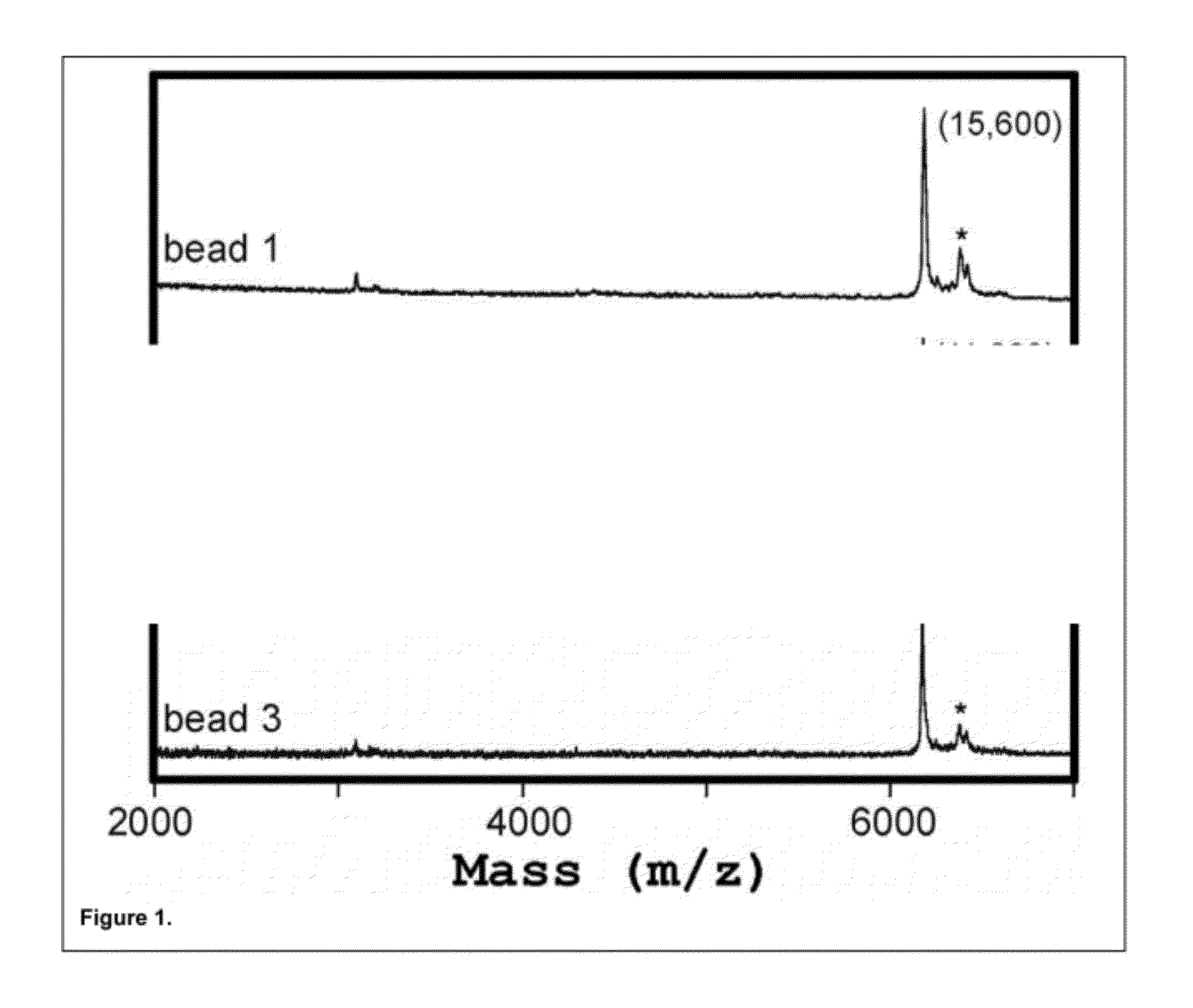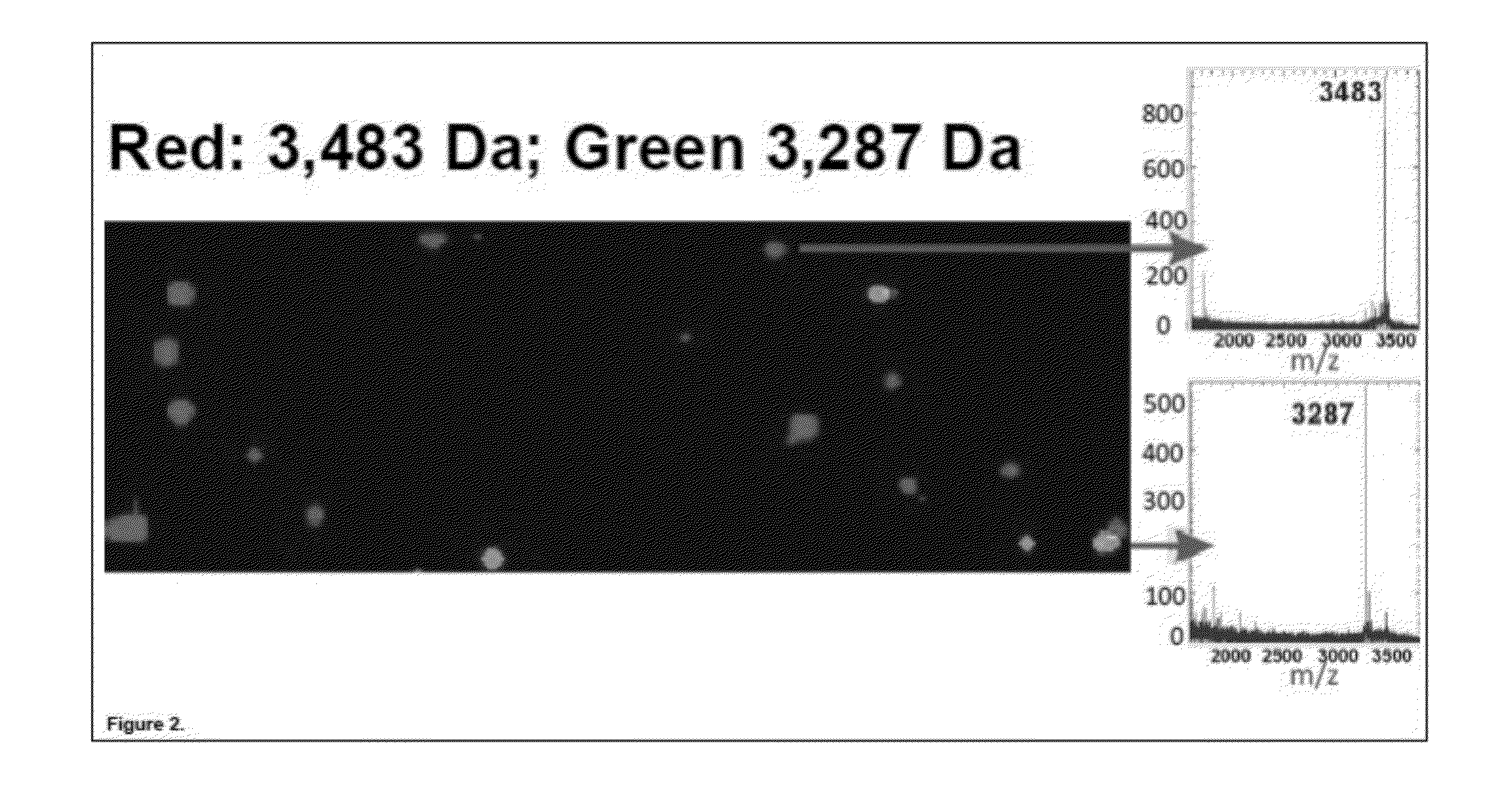Global Proteomic Screening Of Random Bead Arrays Using Mass Spectrometry Imaging
a mass spectrometry and random bead technology, applied in the field of global proteomic screening of random bead arrays using mass spectrometry imaging, can solve the problems of not yet demonstrated commercial viability, unsuitable for proteomic or nucleotide analysis, and the date has not exceeded, and achieves low cost, high precision, and wide commercial availability
- Summary
- Abstract
- Description
- Claims
- Application Information
AI Technical Summary
Benefits of technology
Problems solved by technology
Method used
Image
Examples
example 1
Affinity Purification of Cell-Free Expressed Peptides onto an Agarose Bead Affinity Resin Followed by Mass Spectrometry Detection from Single Beads
[0164]In this Example a test peptide corresponding to a segment of the APC gene, with an expected molecular weight of 6,203 Da, containing an N-terminal FLAG® epitope tag (Sigma-Aldrich, St. Louis, Mo.), was synthesized in a recombinant cell-free transcription / translation reaction according to the manufacturer's instructions (PureSystem; Post Genome Institute Co., LTD., Japan).
[0165]The nascent peptide from the reaction was then purified on mouse anti-FLAG antibody-coated agarose affinity beads (˜75-150 micron diameter). For this, the crude cell-free expression mixtures were diluted with 50 μL of AB-T [100 mM ammonium bicarbonate with 0.1% Triton X-100 (v / v)]. Mouse anti-FLAG antibody coated agarose affinity beads were used in batch mode to purify the cell-free expressed peptides (EZview™ Red Anti-FLAG® M2 Affinity Gel, Sigma-Aldrich, St....
example 2
Mass Spectrometry Readout and Mass-Imaging from Individually Resolved Beads
[0167]In this Example, two test peptides with molecular weights of 3,483 Da and 3,287 Da, each containing an N-terminal FLAG® epitope tag (Sigma-Aldrich, St. Louis, Mo.), were separately synthesized in a recombinant cell-free transcription / translation reaction according to the manufacturer's instructions (PureSystem; Post Genome Institute Co., LTD., Japan). The nascent peptides from each reaction were then separately purified on mouse anti-FLAG antibody-coated agarose affinity beads (EZview™ Red Anti-FLAG® M2 Affinity Gel, Sigma-Aldrich, St. Louis, Mo.) (˜75-150 micron diameter). The beads were then mixed in a 9:1 ratio and manually deposited in a random pattern on a suitable substrate for MALDI-TOF mass spectrometry. The MALDI-TOF matrix (CHCA) was sprayed on in a thin and uniform film and allowed to dry. MALDI-TOF imaging of the surface was performed using an ABI 4800 Plus MALDI-TOF / TOF mass spectrometer (A...
example 3
Mass Spectrometry Readout and Mass-Imaging from Individually Resolved 34 Micron Beads Deposited in Pico-Well Plates: Mass-Tagging of Analyte-Bearing Beads for Identification
[0169]In this Example, 34 micron agarose beads were conjugated to an antibody directed against the HSV epitope tag. The beads were then loaded with different recombinant proteins bearing this HSV epitope tag. The beads were additionally bound to one of three different peptide “mass tags” of unique mass, corresponding to the HSV peptide epitope itself, conjugated on the N-terminus to different fluorophores. The beads were then deposited into a special pico-well plate and mass-imaged by scanning MALDITOF mass spectrometry. Separately, the presence of the recombinant proteins was detected on the same batch of beads by probing with a fluorescently labeled antibody directed against the common VSV-G epitope tag, also present in the recombinant proteins.
Development of Pico-Well Plates for MALDI-TOF Bead Scanning
[0170]In...
PUM
 Login to View More
Login to View More Abstract
Description
Claims
Application Information
 Login to View More
Login to View More - R&D
- Intellectual Property
- Life Sciences
- Materials
- Tech Scout
- Unparalleled Data Quality
- Higher Quality Content
- 60% Fewer Hallucinations
Browse by: Latest US Patents, China's latest patents, Technical Efficacy Thesaurus, Application Domain, Technology Topic, Popular Technical Reports.
© 2025 PatSnap. All rights reserved.Legal|Privacy policy|Modern Slavery Act Transparency Statement|Sitemap|About US| Contact US: help@patsnap.com



